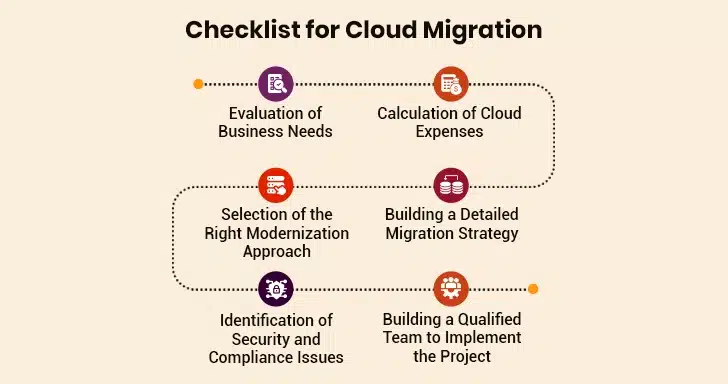Modern IT leaders see the cloud as vital to their operations. Most businesses already run their workloads on the public cloud. This change goes beyond new technology; it helps organizations adapt quickly to market needs.
Moving from traditional data centers to cloud platforms delivers several benefits. Companies eliminate the costs of physical servers and dedicated IT staff. They also get more predictable expenses and avoid surprise maintenance bills and hardware refresh cycles.
Cloud environments let teams work together no matter where they’re located. They also let users scale resources up when demand spikes and scale down when things quiet down. This beats the traditional model of buying hardware for peak capacity and then watching it sit idle most of the time.
This blog explains how tech leaders can plan a successful migration of their data centers to the cloud. It talks about business drivers for cloud migration, explains different migration approaches, and provides a step-by-step migration roadmap.

Table of Contents
Why Migrate to the Cloud: Business Drivers IT Leaders Can’t Ignore
Choosing the Right Migration Approach: The 5 Rs
Step-by-Step Migration Process
How to Overcome Key Migration Challenges
Why Migrate to the Cloud: Business Drivers IT Leaders Can’t Ignore
Business leaders are waking up to a simple fact: data center migration to the cloud delivers advantages that go well beyond updating technology. These fundamental drivers help IT leaders make a strong case for migration.
1. Cost Optimization
Companies that move to the cloud see major cost savings when they eliminate hardware maintenance and expensive infrastructure refresh cycles. The cloud’s pay-as-you-use model turns large capital expenses into predictable operational costs. This is because you pay only for what you actually need.
Cloud migrations significantly reduce operational and infrastructure costs for ongoing operations. Companies also see a considerable drop in infrastructure costs when they make the move. These cost savings come from:
- Flexible resource allocation
- No wasted capacity when demand is low
- Lower licensing costs
2. Elasticity
Elasticity is one of those cloud benefits that sounds good in theory but proves invaluable in practice. Traditional data centers provide a fixed amount of resources. Cloud environments adjust computing resources depending on the changes in demand. This makes the cloud useful for applications with unpredictable resource usage. These include:
- Ecommerce websites where usage rises during peak seasons
- Gaming applications where the user base fluctuates greatly
From Legacy to Agility: Mastering Azure Cloud Migration in 2025
3. Disaster Recovery
Cloud platforms offer advanced disaster recovery options that would cost substantially in traditional data centers. When organizations migrate to cloud environments, they get access to backup systems spread across many locations. This offers protection against:
- Natural disasters (earthquakes, floods, wildfires)
- Cyber-attacks (malware, DDoS, ransomware)
- Power outages and technology failures
Cloud-based disaster recovery uses pay-as-you-go pricing. As a result, companies don’t need big upfront investments in physical infrastructure. They can test recovery procedures without disruption.
4. Innovation
Data center to cloud migration gives access to new technologies that would be difficult to implement in a traditional data center. Cloud providers offer AI/ML services, IoT platforms, and serverless computing options that speed up innovation.
Serverless computing offers many benefits:
- Pricing based on consumption with no charges during idle times
- Automatic scaling to handle unpredictable workloads
- No infrastructure management is needed
These technologies let businesses build advanced capabilities without massive upfront investment. Small companies can implement advanced AI functions through serverless architectures while benefiting from free tiers.
A well-planned data center migration strategy helps businesses achieve all of these benefits. It also positions them for growth in markets that keep getting more competitive over time.
Choosing the Right Migration Approach: The 5 Rs
The choice of migration approach determines the success of a cloud project. The 5 Rs, Rehost, Refactor, Revise, Rebuild, and Replace, give IT leaders a structured way to pick the best migration path for every application.
Every application is different. Some need a little change. Others may require complete rebuilding. Businesses should match an approach to their goals and technical constraints before going ahead with it.
I. Rehost
Rehosting means moving applications to a cloud environment with little change. Applications are shifted from an on-premises environment to the cloud without modification to the underlying architecture. This approach gets you to the cloud quickly while preserving existing functionality.
Rehosting works well for:
- Legacy applications that can’t be easily modified
- Companies that need to exit data centers quickly
- Applications that already perform well and don’t need immediate optimization
Rehosting offers the quickest path to cloud adoption. However, it might not provide benefits native to the cloud. Even so, many companies start their data center to cloud migration this way and enhance their applications later.
II. Refactor (Lift, Tinker, and Shift)
Refactoring makes modest changes to the code to take advantage of cloud capabilities. However, the core application architecture remains unchanged. In this method, development teams can replace some application components with cloud services. They can also tweak database connections and implement cloud-specific APIs.
This approach modifies the application code to improve its performance and scalability significantly. It is also quicker and cheaper when compared to other advanced approaches. Refactoring is thus ideal for applications that need performance improvements but not complete rebuilding.
III. Rearchitect
Rearchitecting changes the architecture of legacy applications. This allows them to take advantage of cloud capabilities. Monolithic applications are broken down into modular components, each of which can be easily modified. This approach thus creates applications that are highly scalable and integrate better with existing systems.
Rearchitecting includes:
- Replacing outdated frameworks and libraries
- Improving application architecture
- Adding better security and performance features
Since this approach requires deeper code modifications, it takes more time and resources than simple refactoring. It can be used for critical applications that need modernization but can’t be replaced.
IV. Rebuild
Rebuilding involves building an application from scratch. Companies choose this approach when their existing legacy applications cannot meet their current requirements or when technical debt makes maintenance expensive.
Rebuilding allows teams to:
- Use cloud-native services
- Utilize modern development practices
- Make applications run faster and scale better
Rebuilding needs a lot of investment. However, it provides better results. Cloud-native applications typically cost less to operate because they use resources more efficiently and automate processes.
V. Replace
Many businesses do not migrate their existing applications. Instead, they replace them with software solutions that provide the same functionality. This method proves useful in the case of standardized business functions.
This approach offers businesses many advantages. These include:
- No need for complex migration
- Less development and maintenance
- Regular updates and improvements
Most migration strategies combine two or more approaches. Businesses should select an approach depending on the technical complexity and future needs of their application. This choice directly impacts their migration timelines, costs, and outcomes. It is, therefore, important to carefully assign the right method for each application. Doing so helps create a strong foundation for cloud transformation.
Step-by-Step Migration Process

A structured approach to migration reduces risks and boosts business value. It also removes barriers that may slow down a project.
Step 1: Assessment
Businesses should start their cloud migration by understanding their current setup. They should make an inventory of everything that needs to be moved, including applications, systems, and technology components. They must also figure out how these components connect with and depend on each other. Understanding these connections is important. It tells which components need to be moved together as a group.
It is essential to look for potential problems during this stage. Teams should identify risks like security gaps or unexpected costs early. Finding these challenges upfront saves significant time and trouble later. The assessment stage thus creates the foundation for a smooth migration.
Step 2: Planning
A migration plan should be created after the evaluation of the existing setup is complete. The plan needs a clear roadmap with timelines and performance metrics to guide the process. It should outline which workloads will be moved to the cloud and in what sequence.
Choosing the right cloud service provider is crucial for migration. Teams should compare these providers based on several factors, such as pricing, available services, scalability, and security features. They need to research to find a provider that can meet their needs effectively.
Step 3: Migration
This step involves actually moving workloads to the cloud. Most organizations divide this stage into phases. Applications with similar characteristics or dependencies are often grouped and moved together.
It is recommended to start with less complex, standalone applications. These create early wins while your team builds expertise. Complex workloads with numerous dependencies come later, after capabilities mature.
Step 4: Validation
Validation makes sure systems perform as expected in their new cloud environment. Performance testing examines response times, resource usage, and functional capabilities of these systems.
Automation tools handle most of the validation process. They perform specific actions to check if the migration is successful. The use of automation reduces human error and speeds up the process.
Step 5: Optimization
Organizations must continuously refine their cloud setup once the migration is complete. This final phase refines configurations. It also addresses any issues found after migration and implements clear governance rules.
Cloud environments differ from traditional data centers. They require ongoing attention. Active management of the cloud helps you get the most value out of your investments.
How to Overcome Key Migration Challenges
Organizations face several challenges when they migrate their data centers to the cloud. To overcome these issues, they should have strategies ready before they start the process.
I. Downtime and Business Continuity
Business disruptions during migration can lead to significant losses. A phased migration approach substantially reduces this risk. Teams should start with non-critical applications. This approach helps them learn valuable lessons they can apply to more complex applications. In addition, they should run thorough tests before the final cutover. Testing under different scenarios (e.g., load testing, security testing, and failover testing) gives a full picture of both performance and resilience.
CapEx vs OpEx: Key Considerations for Cloud Migration
II. Security and Compliance
Security gets tricky when responsibilities are split between the client and the cloud provider. The shared responsibility model draws clear lines. The service provider protects the cloud infrastructure while your company is responsible for securing the data, access controls, and configurations.
In addition, companies need proper planning to meet GDPR and HIPAA regulatory requirements for data protection. Poor security measures can lead to compliance failures, operational disruptions, and data breaches.
III. Cost Overruns
Companies waste about 32% of their cloud budget because they can’t track usage properly. Here’s how to avoid cost overruns:
- Use tools like AWS Budgets to make sure expenses stay in line with the established cloud budget
- Implement reserved instances to enjoy lower hourly rates for using certain resources
- Enable cost anomaly detection to avoid surprises during migration
IV. Application Compatibility
Most older applications need changes to run smoothly in the cloud. A simple lift-and-shift might not be enough. Teams should assess each application properly to determine if it needs refactoring.
Mapping dependencies is also crucial. Migrating components without their dependencies can cause longer downtime. Businesses should move their systems in phases to address this issue.
How Cloud Providers Simplify Migration
Cloud providers have specialized tools that make data center migration to the cloud easier. These tools fix challenges related to migration with automation and monitoring.
1. AWS
AWS offers a migration toolkit built around the AWS Migration Hub. This central dashboard helps teams plan migrations and track progress across multiple AWS solutions. IT teams can monitor application migrations with this unified view no matter which tools they use. AWS Database Migration Service (DMS) helps databases move smoothly while source databases stay up and running. This minimizes downtime considerably.
AWS Snowball devices are a great solution when teams need to move massive amounts of data. These secure appliances can transport terabytes to petabytes of data. They bypass bandwidth limits that could slow down data center migration.
2. Azure
Microsoft’s primary migration tool is Azure Migrate. It provides a unified approach that starts with assessment and follows through to execution. The service automatically identifies on-premises workloads, generates cost estimates for running them in Azure, and recommends the best configurations. After the assessment, Azure Migrate executes the transition through both agentless and agent-based options, depending on what the workloads need.
Azure Site Recovery complements migration efforts even though it was originally designed for disaster recovery. It replicates workloads across environments with extensive capabilities. Microsoft recommends Azure Migrate as the preferred service for migration projects, but Site Recovery remains valuable for scenarios requiring heavy replication.
3. Google Cloud
Google Cloud Platform offers Migrate for Compute Engine as its key migration tool. It is specifically designed for moving VM-based workloads to Google’s infrastructure. The service adapts workloads for Compute Engine. It also takes care of pre-migration validation and testing to ensure a smoother shift to the cloud.
Anthos helps with multi-cloud management. It allows organizations to modernize applications across environments. It also extracts workloads from VMs into containers and manages hybrid deployments through one platform. This flexibility proves useful for phased migrations that span multiple environments.
The Final Word
A well-planned data center migration delivers significant business value by restructuring costs and providing operational flexibility with better disaster recovery options. Companies also get access to new technologies that speed up innovation without heavy upfront expenses.
A successful migration requires smart planning and systematic execution. Security issues, downtime risks, and potential cost overruns need proactive handling. Major cloud providers understand these challenges and have created specialized tools that make the switch smoother.
Companies that approach cloud migration with clear business goals prepare themselves for the flexibility that markets demand. Those who try to rush the process or treat it as a cost-cutting exercise often find themselves managing more complexity for less benefit. The question isn’t whether to migrate anymore. It’s how to do it right for your specific situation and business needs.





